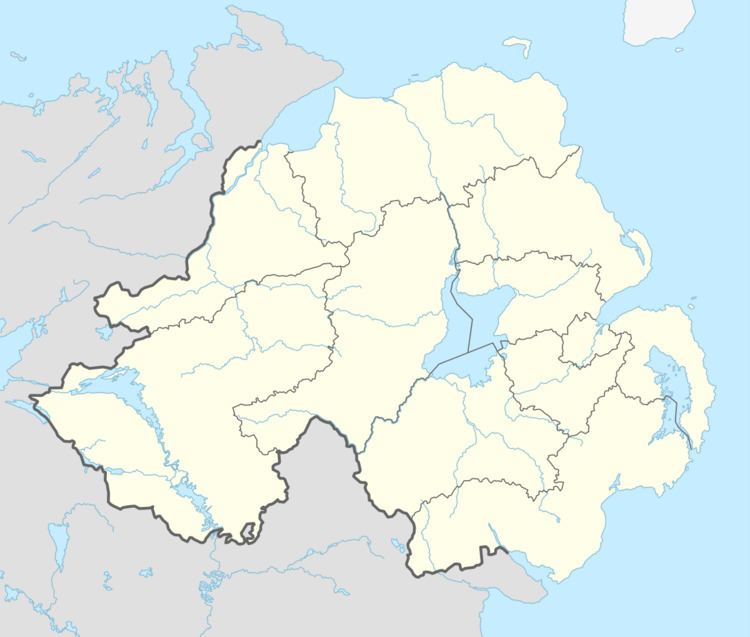Elevation 69 m Year built 1918 Owner Ministry of Defence | Phone +44 28 9442 1301 Province Ulster | |
 | ||
Operator Joint Helicopter Command 07/25 2,780 metres (9,121 ft) asphalt 17/35 1,891 metres (6,204 ft) asphalt Address Aldergrove Base, Aldergrove, Crumlin BT29 4BP, United Kingdom In use Royal Air Force, Joint Helicopter Command Similar RAF Boulmer, RAF Ballykelly, RAF Spadeadam, RAF Bentley Priory, RAF Neatishead | ||
Joint Helicopter Command Flying Station Aldergrove or more simply JHFS Aldergrove is a Joint Helicopter Command flying station located 4.4 miles (7.1 km) south of Antrim, Northern Ireland and 18 miles (29 km) northwest of Belfast. The flying station adjoins Belfast International Airport, sometimes referred to simply as Aldergrove which is the name of the surrounding area. The station shared the Aldergrove runways but had its own separate facilities and helipad.
Contents
- Inter war years
- Second World War
- Post war
- Royal Air Force operations
- Army Air Corps operations
- Current use
- Units based at Aldergrove
- References
The site was formerly RAF Aldergrove a Royal Air Force station which was in operation between 1918 and 2009.
Inter-war years
RAF Aldergrove first opened in 1918 but was not designated as an operational RAF station until 1925.
Various squadrons were posted here during this time:
Second World War
Aldergrove’s location made it an important station of RAF Coastal Command in the Battle of the Atlantic during the Second World War. From the base, long-range reconnaissance aircraft were able to patrol the Eastern Atlantic for U-boats. Some of these patrols ranged as far out as the distant islet of Rockall.
Various squadrons were posted here during this time:
Post war
Aldergrove was designated as a dispersal airfield for the RAF's V bomber force in the 1950s and was included in a reduced list of 26 airfields in 1962. In 1968 No. 23 Maintenance Unit RAF was responsible for the maintenance of McDonnell Douglas F-4 Phantom II's in RAF service, with 116 aircraft passing through on their way to front line service. Aldergrove was also the main servicing and reconditioning station for the English Electric Canberra from their introduction in 1951. In 1976, the station had a staff of 2,500 RAF personnel and 1,500 civilians.
Various squadrons were posted here between 1945 and 1985:
Royal Air Force operations
No. 72 Squadron operated Westland Wessex HC.2 helicopters from Aldergrove from 12 November 1981 until its disbandment in 2002.
No. 230 Squadron RAF was re-deployed from Germany to RAF Aldergrove in 1992, where it operated Westland Puma HC.1 helicopters until its relocation to RAF Benson in November 2009.
No. 18 Squadron RAF also operated detachments of Boeing Chinook during the late 80s in support of the British Army in Northern Ireland.
The following RAF Regiment squadrons were here at some point:
Army Air Squadron Operations
The 17/21st Lancers Air Squadron based at RAF Aldergrove from 1969 to 1971 operating with Sioux Helicopters and a Fixed Wing Beaver aircraft
Army Air Corps operations
The Army Air Corps also operated Westland Lynx and Westland Gazelle helicopters as well as de Havilland Canada DHC-2 Beaver aircraft in its joint operations with the RAF's Reconnaissance Intelligence Centre (Northern Ireland); the Beaver was replaced by the Britten-Norman Islander late in 1988.
During 1991 No. 655 Squadron AAC moved from RAF Ballykelly to Aldergrove with the Westland Lynx.
On 1 October 1993 the Northern Ireland Regiment Army Air Corps was retitled 5 Regiment Army Air Corps.
On 4 August 2008 651 Squadron Army Air Corps moved back to Northern Ireland from RAF Odiham after almost 50 years after its first deployment here.
Aldergrove is now home to the Joint Helicopter Force Northern Ireland (JHF(NI)), which provides Gazelle and Islander aircraft in support of the Police Service of Northern Ireland (PSNI) and military units for Operation Helvetic, and for other operations abroad. Its current role is to support this flying.
Due to the closure of RAF Machrihanish, the base is now used annually for Air Training Corps cadets as a training camp, where cadets from Scotland and Northern Ireland Region gather for a week of fieldcraft, shooting, first aid and other activities.
During 2003 Air Force One arrived at the airport in support of U.S. Presidential visits to Northern Ireland.
Current use
Aldergrove officially ceased to be an RAF Station on 20 September 2009 when, after the annual Battle of Britain parade, the RAF ensign was lowered for the last time and the Joint Helicopter Command flag was hoisted in its place.
